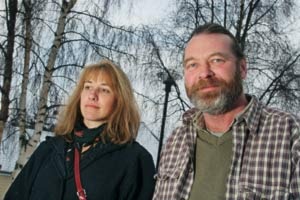There’s cave art in the Chocolate Claim.
Scratched on small squares of rough paper, some of the spindly hunters brandish spears — others sport erections.
“It’s a little bit of a departure from my usual representational work,” said watercolour artist Andrew Macdonald, who traditionally paints landscapes.
Macdonald jokingly blames his new, Neolithic fascination on US president George W. Bush.
“Bush’s foreign policy is to bomb everything into the Stone Age,” he said.
“So I started playing around with Neolithic symbols, cave art and stone art.”
Beside Macdonald’s metaphysical swirls and mottled, dark washes hang a series of Cynthia Hunt’s watercolour close-ups, which include tidal pools and pebbles in streambeds.
“I’m playing around in the back of the cave, on the walls, and she’s looking out the front door,” said Macdonald.
Both artists work in watercolours, and a couple of years ago they started talking about a joint show.
We wanted to do something different, to suggest a contrast, said Macdonald.
“Because our work was very similar.
“And then I got into this stuff in the back of the cave — it just happened, I’m not sure how or why.”
It will be Hunt’s first show in Whitehorse, and the Dawson artist was still working on a couple of pieces for it last week.
“You put so many hours into them,” she said, after laying out a few of her unframed works.
“Then you whip them out and they look so funny; they’re just these little pieces of paper.”
But her little pieces of paper are captivating, magnifying small moments in nature that would often go unnoticed.
“I want to get people to look more closely at how wonderful the world is around us,” she said.
“And to reconnect with it before it gets wrecked.”
The show, aptly called Elemental, deals with themes that go all the way back to the beginning of time.
“The most important elements in my work are rocks, water and early life forms,” said Hunt.
“Even the act of painting itself is elemental to man.”
It was seeking out art’s elemental origins that led Macdonald to cave art in the first place.
“The Bible got it wrong,” he said with a laugh.
“In the beginning it wasn’t the Word — in the beginning was drawings and images.”
Cave art is a protolanguage, he said.
“And I’m hoping people will look at these works and see a little bit of who they were 50,000 years ago, compared to who they are today.”
Macdonald copied some of his cave drawings from books on Neolithic art, but others are playful explorations, he said.
“We can never know what these symbols represented,” he said.
“But it’s so old that every human being on the planet must have it etched on their brains somewhere, in their collective unconscious.”
Macdonald, who is used to painting sunlight filtering through snowy trees, is still not sure what triggered his bizarre bout of abstract work.
“This stuff evolved in the autumn,” he said.
Fascinated with reductionism, he’s always fooled around with various ways of simplifying his work, he said.
“And it doesn’t get any simpler than this.”
But people who come expecting to see realistic landscapes might be disappointed, said Macdonald with a laugh.
Hunt’s work, like Macdonald’s, has departed from large landscapes, but it’s still realistic.
“I’m just starting to move in and paint things close-up,” she said.
“It’s almost a scientific view of looking at the elements in the landscape.”
It’s a natural progression for Hunt, who works in the Tombstones as a naturalist in the summers.
Her scientific eye dissects the landscape and helps shape her art.
“When I’m sitting and looking at how light and form works on a landscape, and the brilliance of the natural world, for me it’s not just a leaf, it’s a cottonwood, and it’s not just a fish, it’s a grayling,” she said.
But her work is not only representational.
“I always put myself in the landscape,” said Hunt.
“Hidden in the work, through colour and placement of the subject, is an abstraction of my feelings.
“So what appears to be a simple landscape is really a reflection of what’s going on inside.”
However, everyone takes something different from the images, she said.
